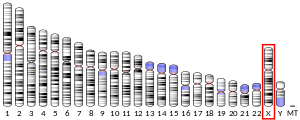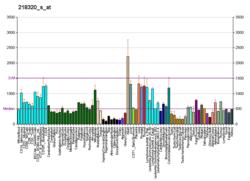NDUFB11
NADH dehydrogenase [ubiquinone] 1 beta subcomplex subunit 11, mitochondrial (NADH-ubiquinone oxidoreductase ESSS subunit) is an enzyme that in humans is encoded by the NDUFB11 gene.[5][6][7] NADH dehydrogenase (ubiquinone) 1 beta subcomplex subunit 11 is an accessory subunit of the NADH dehydrogenase (ubiquinone) complex, located in the mitochondrial inner membrane. It is also known as Complex I and is the largest of the five complexes of the electron transport chain.[8] NDUFB11 mutations have been associated with linear skin defects with multiple congenital anomalies 3 and mitochondrial complex I deficiency.[7]
| ESSS subunit of NADH:ubiquinone oxidoreductase (complex I) | |||||||||
|---|---|---|---|---|---|---|---|---|---|
| Identifiers | |||||||||
| Symbol | ESSS | ||||||||
| Pfam | PF10183 | ||||||||
| InterPro | IPR019329 | ||||||||
| |||||||||
Gene
The NDUFB11 gene is located on the p arm of chromosome X in position 11.23 and is 2,994 base pairs long.[9][10]
Protein
The NDUFB11 protein weighs 17 kDa and is composed of 153 amino acids.[9][10] NDUFB11 is a subunit of the enzyme NADH dehydrogenase (ubiquinone), the largest of the respiratory complexes.
Structure
The structure is L-shaped with a long, hydrophobic transmembrane domain and a hydrophilic domain for the peripheral arm that includes all the known redox centers and the NADH binding site.[8] It has been noted that the N-terminal hydrophobic domain has the potential to be folded into an alpha helix spanning the inner mitochondrial membrane with a C-terminal hydrophilic domain interacting with globular subunits of Complex I. The highly conserved two-domain structure suggests that this feature is critical for the protein function and that the hydrophobic domain acts as an anchor for the NADH dehydrogenase (ubiquinone) complex at the inner mitochondrial membrane.[7]
Function
The protein encoded by this gene is an accessory subunit of the multisubunit NADH:ubiquinone oxidoreductase (complex I) that is not directly involved in catalysis. Mammalian complex I is composed of 45 different subunits. It locates at the mitochondrial inner membrane. This protein complex has NADH dehydrogenase activity and oxidoreductase activity. It transfers electrons from NADH to the respiratory chain. The immediate electron acceptor for the enzyme is believed to be ubiquinone. Alternative splicing occurs at this locus and two transcript variants encoding distinct isoforms have been identified.[7] Initially, NADH binds to Complex I and transfers two electrons to the isoalloxazine ring of the flavin mononucleotide (FMN) prosthetic arm to form FMNH2. The electrons are transferred through a series of iron-sulfur (Fe-S) clusters in the prosthetic arm and finally to coenzyme Q10 (CoQ), which is reduced to ubiquinol (CoQH2). The flow of electrons changes the redox state of the protein, resulting in a conformational change and pK shift of the ionizable side chain, which pumps four hydrogen ions out of the mitochondrial matrix.[8]
Clinical significance
Mutations in the human gene are associated with linear skin defects with mitochondrial complex I deficiency and microphthalmia with linear skin defects syndrome.[7] Mitochondrial complex I deficiency is a disorder of the mitochondrial respiratory chain that causes a wide range of clinical manifestations from lethal neonatal disease to adult-onset neurodegenerative disorders.[11][12] In cases of pathogenic NDUFB11 mutations, complex I deficiency with lactic acidosis and sideroblastic anemia has been found to occur.[13] Mutations in NDUFB11 have also been linked to microphthalmia with linear skin defects syndrome with neurological and cardiac abnormalities.[14]
Interactions
NDUFB11 has been shown to have 55 binary protein-protein interactions including 32 co-complex interactions. NDUFB11 appears to interact with FATE1, GPR42, CLDN7, GJB1, HIBADH, EBP, GPR152, GPR101, TIMMDC1, TIMMDC1, PPBP, and CRELD2.[15]
References
- GRCh38: Ensembl release 89: ENSG00000147123 - Ensembl, May 2017
- GRCm38: Ensembl release 89: ENSMUSG00000031059 - Ensembl, May 2017
- "Human PubMed Reference:". National Center for Biotechnology Information, U.S. National Library of Medicine.
- "Mouse PubMed Reference:". National Center for Biotechnology Information, U.S. National Library of Medicine.
- Cui Y, Yu L, Gong R, Zhang M, Fan Y, Yue P, Zhao S (June 1999). "Cloning and tissue expressional characterization of a full-length cDNA encoding human neuronal protein P17.3". Biochemical Genetics. 37 (5–6): 175–85. doi:10.1023/A:1018734605214. PMID 10544803.
- Carroll J, Shannon RJ, Fearnley IM, Walker JE, Hirst J (December 2002). "Definition of the nuclear encoded protein composition of bovine heart mitochondrial complex I. Identification of two new subunits". The Journal of Biological Chemistry. 277 (52): 50311–7. doi:10.1074/jbc.M209166200. PMID 12381726.
- "Entrez Gene: NDUFB11 NADH dehydrogenase (ubiquinone) 1 beta subcomplex, 11, 17.3kDa".

- Voet D, Voet JG, Pratt CW (2013). "Chapter 18". Fundamentals of biochemistry: life at the molecular level (4th ed.). Hoboken, NJ: Wiley. pp. 581–620. ISBN 978-0-470-54784-7.
- Zong NC, Li H, Li H, Lam MP, Jimenez RC, Kim CS, et al. (October 2013). "Integration of cardiac proteome biology and medicine by a specialized knowledgebase". Circulation Research. 113 (9): 1043–53. doi:10.1161/CIRCRESAHA.113.301151. PMC 4076475. PMID 23965338.
- "NADH dehydrogenase [ubiquinone] 1 beta subcomplex subunit 11". Cardiac Organellar Protein Atlas Knowledgebase (COPaKB).
- "NDUFB11 - NADH dehydrogenase [ubiquinone] 1 beta subcomplex subunit 11, mitochondrial precursor - Homo sapiens (Human) - NDUFB11 gene & protein". www.uniprot.org. Retrieved 2018-08-24.

- "UniProt: the universal protein knowledgebase". Nucleic Acids Research. 45 (D1): D158–D169. January 2017. doi:10.1093/nar/gkw1099. PMC 5210571. PMID 27899622.
- Torraco A, Bianchi M, Verrigni D, Gelmetti V, Riley L, Niceta M, et al. (March 2017). "A novel mutation in NDUFB11 unveils a new clinical phenotype associated with lactic acidosis and sideroblastic anemia". Clinical Genetics. 91 (3): 441–447. doi:10.1111/cge.12790. PMID 27102574.
- van Rahden VA, Fernandez-Vizarra E, Alawi M, Brand K, Fellmann F, Horn D, Zeviani M, Kutsche K (April 2015). "Mutations in NDUFB11, encoding a complex I component of the mitochondrial respiratory chain, cause microphthalmia with linear skin defects syndrome". American Journal of Human Genetics. 96 (4): 640–50. doi:10.1016/j.ajhg.2015.02.002. PMC 4385192. PMID 25772934.
- NDUFB11 "55 binary interactions found for search term NDUFB11" Check
|url=value (help). IntAct Molecular Interaction Database. EMBL-EBI. Retrieved 2018-08-25.
Further reading
- Petruzzella V, Tessa A, Torraco A, Fattori F, Dotti MT, Bruno C, et al. (March 2007). "The NDUFB11 gene is not a modifier in Leber hereditary optic neuropathy". Biochemical and Biophysical Research Communications. 355 (1): 181–7. doi:10.1016/j.bbrc.2007.01.140. PMID 17292333.
- Kohda M, Tokuzawa Y, Kishita Y, Nyuzuki H, Moriyama Y, Mizuno Y, et al. (January 2016). "A Comprehensive Genomic Analysis Reveals the Genetic Landscape of Mitochondrial Respiratory Chain Complex Deficiencies". PLOS Genetics. 12 (1): e1005679. doi:10.1371/journal.pgen.1005679. PMC 4704781. PMID 26741492.
This article incorporates text from the United States National Library of Medicine, which is in the public domain.




